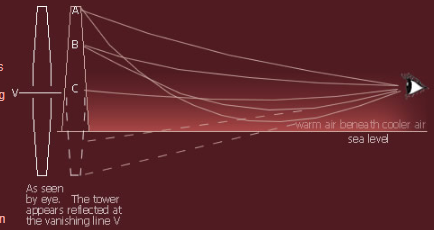Selsea Mirage & Vanishing Lines
Selsea Mirage & Vanishing Lines: Exploring the Fascinating World of Atmospheric Optics
Have you ever witnessed a breathtaking mirage at the beach, where distant objects seem to appear as if reflected in water? One such captivating phenomenon is the Selsea Mirage, observed from Selsey beach in southern England. In this article, we will delve into the intricacies of this mesmerizing optical illusion and explore the concept of vanishing lines associated with it.
The Selsea Mirage, classified as an 'inferior mirage,' occurs when a layer of abnormally warm air forms above the cooler layers near the sea. As light passes through these varying temperature layers, it undergoes refraction, causing the rays from the tops of buildings to appear as if they are emanating from the horizon. Our brain interprets this phenomenon as a reflection on the water's surface, creating a surreal visual experience.
However, the Selsea Mirage holds more surprises beyond its mirroring effect. When observing this mirage, you may notice that the horizon seems to vanish, and the base of buildings and low-lying land becomes invisible both below and above the line connecting the 'real' view and the mirage. This intriguing phenomenon is known as the 'vanishing-line' effect.
To better understand the mechanics behind the Selsea Mirage and its vanishing lines, let's take a closer look at a ray diagram. Although ray diagrams for mirages are often exaggerated in terms of vertical scale, they provide valuable insights. In this diagram, we can observe various rays between the eye and a distant tower. Two rays originating from the top of the tower reach the observer's eye. The upper ray curves slightly downward towards the warmer air, while the lower ray sharply bends, creating the illusion of a tower reflected in water. Rays originating from lower points on the tower undergo similar bending.
However, there is a distinct scenario at position (C) in the diagram. Only one ray reaches the observer's eye, and rays from lower portions of the tower fail to reach the eye altogether, rendering that part of the tower invisible. This specific level, denoted as (C), represents the mirage's "vanishing-line." At the vanishing line, the 'real' view and the inverted mirage view converge, obscuring any details of the scene below it. Notably, the vanishing line rises higher as the observed object becomes more distant.
It is worth mentioning that mirages can exhibit an opposite effect where they appear above the object rather than below it. Known as 'superior mirages,' these phenomena can be extreme, as exemplified by the captivating Fata Morgana. Moreover, mirages involving the sun have been known to produce a remarkable optical phenomenon called the green flash.
The Selsea Mirage and its associated vanishing lines offer a captivating glimpse into the fascinating world of atmospheric optics. By understanding the interplay between temperature layers and light refraction, we can unravel the secrets behind these awe-inspiring illusions. Next time you find yourself at a beach or coastal area, keep an eye out for the enchanting Selsea Mirage and let it transport you to a realm where reality and illusion intertwine.
Note: This article has been automatically converted from the old site and may not appear as intended.

Mirage from Selsey beach, southern England imaged by Mark Parrish April 6, '08 shortly after sunset, the Portsmouth skyline 23km away is seen apparently mirrored in the sea. ©Mark Parrish, shown with permission
The mirage, called an 'inferior mirage' because the image is below the real object, is produced by a layer of abnormally warm air heated by the sea and beneath cooler layers. Light passing at low angles across the layers is refracted so that rays coming from the tops of the building appear to be coming upwards from the horizon. Our brain interprets that as a reflection from water.
There is more. The horizon is missing and the base of buildings and low lying land cannot be seen either below or above the line joining the 'real' view and the mirage. This is a 'vanishing-line' effect.
The ray diagram at right tries to show what is happening but like all mirage ray diagrams the vertical scale has to be grossly exaggerated. All possible rays between the eye and a distant tower are shown. Two rays from the tower top (A) reach the eye. The upper one is slightly curved downwards towards the warmer air. The lower ray is sharply curved and appears to the eye to come from a tower reflected in water. Rays from lower down (B) do the same. Position (C) is different. Only one ray reaches the eye. Rays from lower down the tower cannot reach the eye at all - that part of the tower is invisible!
The level (C) is the level of the mirage "vanishing-line". The 'real' view and inverted mirage view join at the vanishing line and the eye can see no details of the scene that are below it. the more distant the object, the higher is the vanishing line
When the mirage is above the object it is called 'superior'. An extreme example, a Fata Morgana, is here. Mirages of the sun can produce a green flash.

Note: this article has been automatically converted from the old site and may not appear as intended. You can find the original article here.
Reference Atmospheric Optics
If you use any of the definitions, information, or data presented on Atmospheric Optics, please copy the link or reference below to properly credit us as the reference source. Thank you!
-
<a href="https://atoptics.co.uk/blog/selsea-mirage-vanishing-lines/">Selsea Mirage & Vanishing Lines</a>
-
"Selsea Mirage & Vanishing Lines". Atmospheric Optics. Accessed on December 26, 2024. https://atoptics.co.uk/blog/selsea-mirage-vanishing-lines/.
-
"Selsea Mirage & Vanishing Lines". Atmospheric Optics, https://atoptics.co.uk/blog/selsea-mirage-vanishing-lines/. Accessed 26 December, 2024
-
Selsea Mirage & Vanishing Lines. Atmospheric Optics. Retrieved from https://atoptics.co.uk/blog/selsea-mirage-vanishing-lines/.